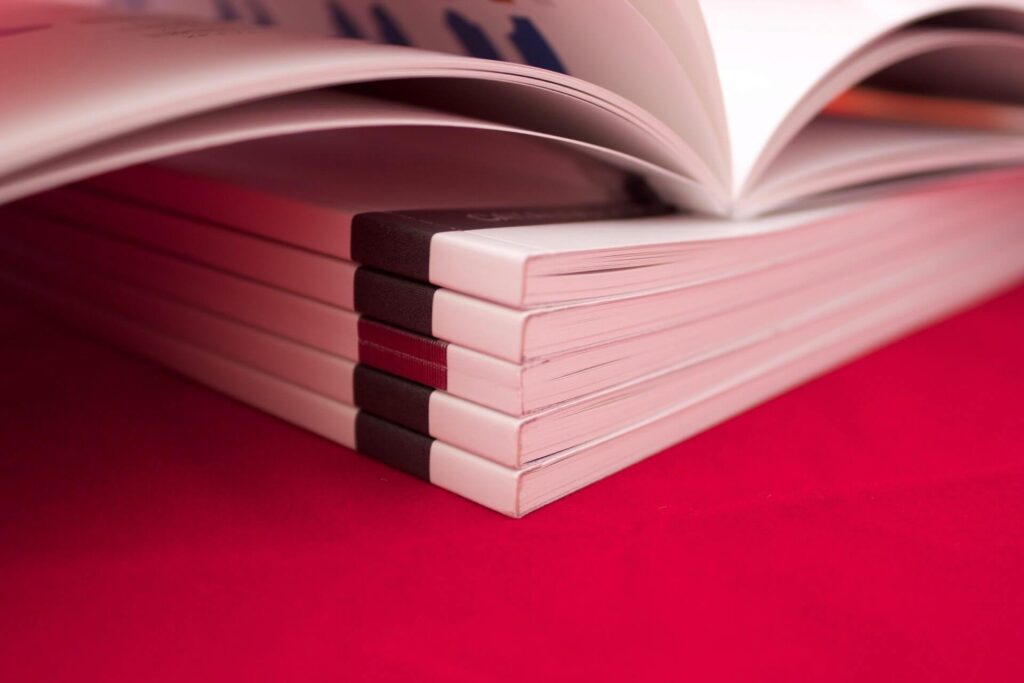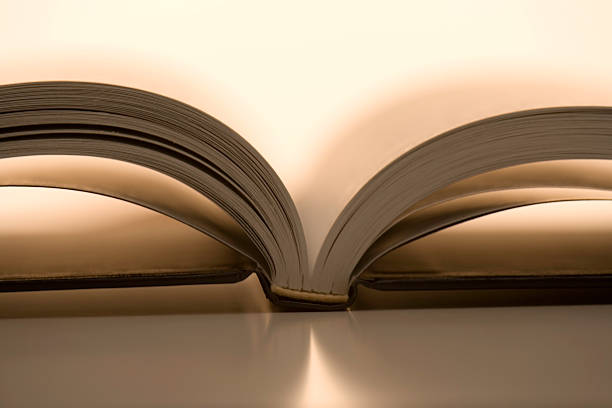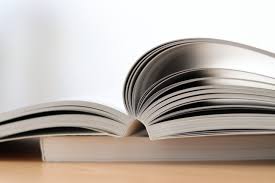
The spine is a critical component in perfect bound printing, significantly impacting the book’s visual appeal and durability. It secures the pages together, making the spine design crucial for a professional finish. Printbooks, a top provider of hardcover book printing in Australia, emphasizes the importance of spine design. They offer detailed advice to authors and publishers on creating the ideal spine for their perfect bound books.
Calculating the spine width accurately is key for a flawless book binding process. The width is calculated by multiplying the page count by the paper’s viscosity, yielding the precise inches for the spine. If the page count is below the required minimum for the chosen binding method, using a thicker stock can help achieve the desired spine width and quality. Printbooks ensures the spine width on the cover design aligns perfectly for hardcover bookbinding in Australia. They provide a PDF proof to authors, showing the spine width before production.
Printbooks also pays close attention to the spine text placement. This text must be small enough, leaving at least 1/8 inch on each side. Such meticulous attention to detail enhances the book’s professional appearance, elevating the quality of perfect bound book printing.
Significance of Perfect Bound Printing
Since the 1930s, perfect bound printing has been a cornerstone in the publishing world. The use of a soft cover in perfect bound printing enhances the visual appeal and is cost-effective, making it ideal for books with larger page counts, such as manuals and yearbooks. It has transformed the production of paperback books. This method cuts and presses the spine edge of pages, creating notches that get glued over the spine. It’s a cost-effective and efficient approach to making books and magazines.
Historical Overview of Perfect Binding
The evolution of perfect binding is marked by a blend of simplicity and a professional finish. Over time, it has become a top choice for various publications, from hefty hardcovers to slim paperbacks. It’s essential to grasp the manufacturing variances that impact spine text and color placement during design. This ensures a consistent and polished outcome. The quality of paper used for the internal pages of perfect bound books varies, with budget options printed on 100gsm paper and premium options on 150gsm paper for improved durability and presentation.
- Softcover binding, particularly perfect binding, dominates the printing sector.
- Books with over 28 pages are ideal for softcover binding, fitting paperbacks, magazines, and softcover novels.
- Perfect bound printing suits thick, high-page-count books that can’t be saddle-stitched.
- It’s advised for books with more than 500 pages, with a minimum of 28 pages and the best results above 92 pages.
Perfect bound printing stands out for its cost-effective and durable binding solution across various book projects. From small runs to large productions, it ensures a professional finish. By delving into its history and evolution, publishers and printers can guarantee a successful outcome.
Perfect Bound Printing

Perfect bound printing is a dominant method in the print sector, especially for books, magazines, and catalogues – be it black only, or printed CMYK with full, printed colours.. It involves gathering pages into a block and securing them to a cover with a strong adhesive. This method produces a professional, durable, and economical binding suitable for various page counts and paper types.
The process of perfect bound printing includes several critical steps:
- Gathering the pages to create the book block
- Selecting an appropriate adhesive, such as PUR (Polyurethane Reactive) or EVA (Ethylene-Vinyl Acetate), to bind the pages together
- Attaching the soft cover to the book block, ensuring a seamless and secure binding
- Trimming the edges to create a clean, professional finish
Perfect bound printing stands out for its versatility. It suits a broad spectrum of print projects, from compact booklets to extensive catalogues. Publishers, marketers, and businesses favor it for its ability to produce high-quality, professional materials that are both resilient and budget-friendly.
For printing books, magazines, or other publications, perfect bound printing is a top choice. Its dependable binding, broad applicability, and customization ease make it a key player in the print industry.
Advantages and Limitations of Perfect Binding

Comparative Analysis
Perfect binding is a favored method for book production, known for its affordability and professional look. It stands out when compared to other methods like saddle stitch, spiral binding, and thread binding. Yet, it’s crucial to understand its limitations when choosing a binding method for a print project.
When considering perfect bound books, the quality of paper used for the internal pages is essential. Budget quality is typically printed on 100gsm paper, while premium quality features a heavier 150gsm paper for improved durability and presentation.
One key benefit of perfect binding is its efficiency in large-scale production. Paperback books, often bound this way, are less expensive than hardcovers. This makes it an economical choice for self-publishers and small businesses. Moreover, perfect binding allows for quick production, with turnaround times as short as 2 business days, ideal for authors with deadlines.
It also provides a polished look, with a neat spine and the option for printed titles. This is especially valuable for books, brochures, and other materials aiming to project quality and authority. Plus, it’s adaptable for a broad range of page counts, fitting various print projects.
Yet, perfect binding isn’t ideal for all books. It may not suit hardcover books or publications needing a flat, easy-to-read format, like cookbooks or manuals. Also, it requires a spine thickness of at least 2mm, limiting its use for very thin or thick books.
When deciding on a binding method, it’s vital to consider the pros and cons of perfect binding versus other options like saddle stitch, spiral binding, and thread binding. Each method has unique advantages and drawbacks. The choice should align with the project’s specific needs, including page count, paper quality, and desired look and functionality.
The Binding Process
The perfect bound printing process is a detailed and refined technique. It guarantees a high-quality, durable, and professional-looking final product. This method is ideal for publications with 50 pages or more, surpassing saddle stitching in larger books.
It starts with aligning and squaring the internal pages for precise arrangement. The spine is then clamped securely to maintain stability. Next, the right amount of adhesive, usually polyvinyl acetate (PVA) glue, is applied, considering the spine’s thickness. This glue is celebrated for its toughness and flexibility, offering a strong bond for the book’s spine.
After applying the adhesive, the cover material is carefully chosen and applied. Cover stocks range from 300gsm to 350gsm paper, offering strength and various finishes like glossy UV or textured linen. The cover is scored and folded to match the text block’s dimensions, ensuring a professional and visually appealing finish.
The final step involves drying the bound book under pressure, like in a book press. This step ensures a flawless and secure binding. Perfect binding is thus an excellent choice for magazines, books, journals, and catalogues of all sizes.
Companies like MVP Print offer customization options and expedited services for perfect binding needs. They cater to the diverse requirements of book publishers and printers.
Material Selection for Perfect Bound Printing
The choice of materials in perfect bound printing is vital for the final product’s quality, durability, and look. In Australia, authors, publishers, and printing services have various options for cover stocks, adhesives, and finishing touches. These choices significantly impact the book’s overall appearance and functionality.
If the page count is below the required minimum for a chosen binding method, using a thicker stock could be a solution to achieve the desired quality in the binding job.
For the Outer Covers, 300-350 GSM stocks are favored for their strength and attractive appearance. The adhesive selection is also critical, with polyvinyl acetate (PVA) and hot melt adhesives leading the industry. These adhesives provide a robust, enduring binding that stands up to frequent handling.
For the inner pages, typically for coated stocks a Gloss or Silk paper is used, however if the application is to be written om, and uncoated paper (such as laser bond) is a good consideration.
Many perfect bound books are finished with a glossy UV laminate for added shine and protection. This coating not only boosts the book’s visual appeal but also shields the cover from damage. By grasping the characteristics and typical applications of these materials, Australian creators and printers can make well-informed choices for their projects.








